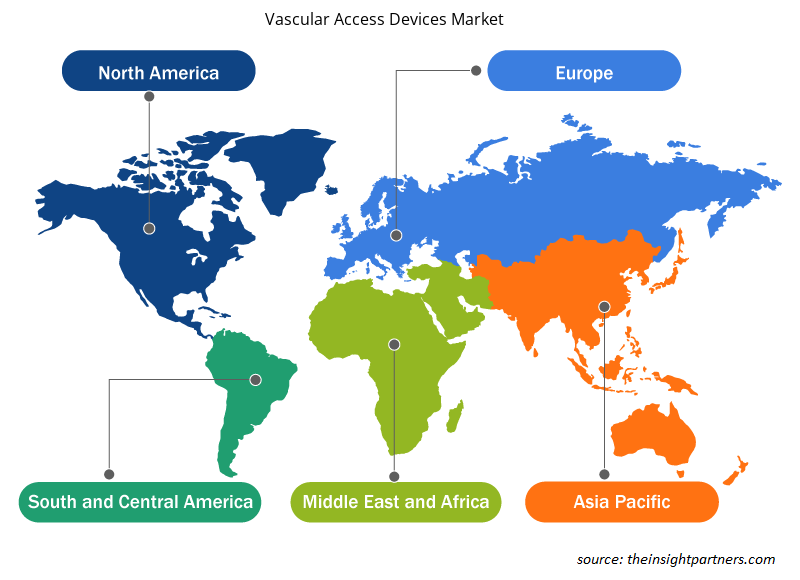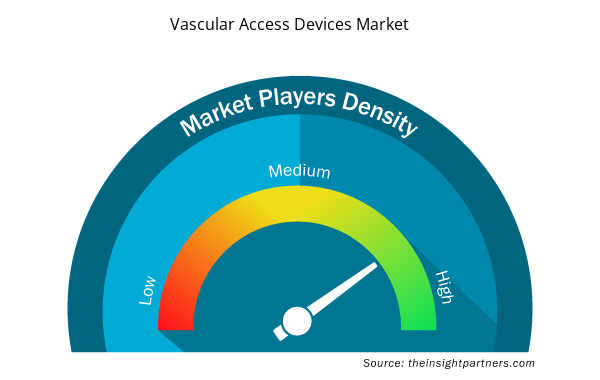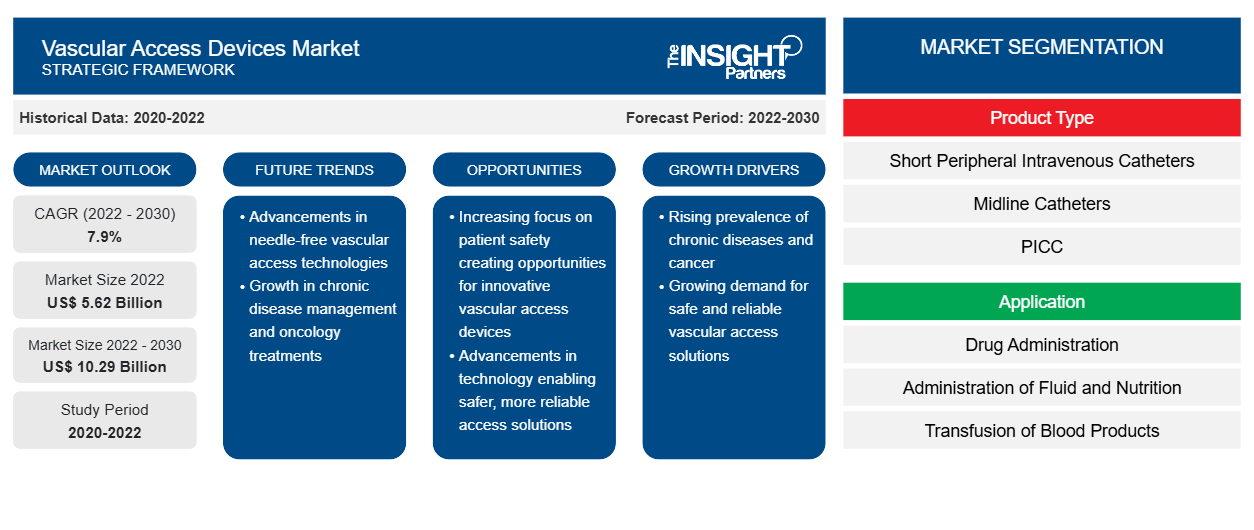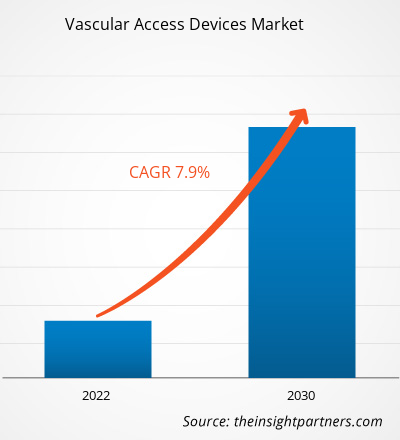[研究报告] 2022 年血管通路设备市场价值为 56.2 亿美元,预计到 2030 年将达到 102.9 亿美元。预计 2022-2030 年期间的复合年增长率为 7.9%。CAGR of 7.9% during 2022–2030.
市场洞察和分析师观点:
血管通路装置通过多个解剖位置置入上腔静脉或下腔静脉——颈内静脉、锁骨下静脉、颈外静脉和股静脉。血管通路装置市场规模不断增长,主要原因是慢性病患病率上升和化疗需求增加。此外,公司为保持市场竞争力而采取的战略举措也推动了市场增长。在预测期内,人工智能机器人静脉通路装置的使用量大幅增加,可能会带来新的血管通路装置市场趋势。
增长动力和挑战:
化疗是一种主要治疗或辅助治疗,通过施用强效药物来缩小或消除肿瘤。因此,癌症病例的增加推动了对化疗程序的需求。根据国际癌症研究机构 (IARC) 的估计,2020 年全球报告了 1930 万例新癌症病例,约 1000 万人死于该疾病。根据南非国家癌症登记处 (NCR) 的数据,2020 年诊断出约 110,000 例新癌症病例,癌症相关死亡人数超过 56,000 人。此外,预计未来几十年疾病负担将增加,到 2030 年和 2040 年,新癌症病例估计将分别上升至 138,000 例和 175,000 例,而癌症相关死亡率将在上述年份上升至 73,000 例和 94,000 例。因此,癌症患病率的上升推动了血管通路设备市场的增长。
定制此报告以满足您的需求
您可以免费定制任何报告,包括本报告的部分内容、国家级分析、Excel 数据包,以及为初创企业和大学提供优惠和折扣
- 获取此报告的关键市场趋势。这个免费样品将包括数据分析,从市场趋势到估计和预测。
报告细分和范围:
血管通路设备市场分析考虑了以下几个部分:产品类型、应用、插入途径、最终用户和地理位置。按产品类型,市场细分为短外周静脉导管、中线导管、PICC(外周插入中心导管)、中心导管、植入式端口和配件。中心导管细分市场进一步细分为CICC(中心插入中心导管)、FICC(股动脉插入中心导管)和其他。根据应用,血管通路设备市场细分为药物管理、液体和营养管理、血液制品输注和其他。根据插入途径,市场分为皮下和静脉。根据最终用户,市场细分为医院和诊所、门诊手术中心和其他。血管通路设备市场报告的范围包括北美(美国、加拿大和墨西哥)、欧洲(西班牙、英国、德国、法国、意大利和欧洲其他地区)、亚太地区(韩国、中国、日本、印度、澳大利亚和亚太其他地区)、中东和非洲(南非、沙特阿拉伯、阿联酋和中东和非洲其他地区)以及南美洲和中美洲(巴西、阿根廷和南美洲和中美洲其他地区)。
节段分析:
血管通路设备市场按产品类型细分为短外周静脉导管、中线导管、PICC(外周插入中心导管)、中心导管、植入式端口和配件。中心导管细分市场细分为 CICC(中心插入中心导管)、FICC(股动脉插入中心导管)和其他。2022 年,短外周静脉导管部分占据了血管通路设备最大的市场份额,预计该部分在 2022-2030 年期间将录得最高复合年增长率。
根据应用,血管通路设备市场细分为药物管理、液体和营养管理、血液制品输注等。2022 年,药物管理领域占据最大份额,预计在 2022-2030 年期间将实现最高复合年增长率。
根据插入途径,血管通路设备市场分为皮下和静脉。静脉部分在 2022 年占据了更大的市场份额,预计在 2022-2030 年期间将录得更高的复合年增长率。
根据最终用户,市场分为医院和诊所、门诊手术中心和其他。医院和诊所领域的血管通路设备市场可能会在 2022-2030 年期间增长。
区域分析:
北美是全球血管通路设备市场增长的最大贡献者。预计亚太地区将在 2022-2030 年期间实现最高的复合年增长率。由于慢性病患病率不断上升、老年人口不断增加、主要市场参与者参与新产品和现有产品的开发以及技术进步不断提高,北美在 2022 年占据了全球市场的最大份额。在北美,美国在 2022 年占据了最大的市场份额。
血管通路设备市场区域洞察
Insight Partners 的分析师已详尽解释了预测期内影响血管通路设备市场的区域趋势和因素。本节还讨论了北美洲、欧洲、亚太地区、中东和非洲以及南美洲和中美洲的血管通路设备市场细分和地理分布。

- 获取血管通路设备市场的区域特定数据
血管通路设备市场报告范围
| 报告属性 | 细节 |
|---|---|
| 2022 年市场规模 | 56.2亿美元 |
| 2030 年的市场规模 | 102.9亿美元 |
| 全球复合年增长率(2022 - 2030 年) | 7.9% |
| 史料 | 2020-2022 |
| 预测期 | 2022-2030 |
| 涵盖的领域 | 按产品类型
|
| 覆盖地区和国家 | 北美
|
| 市场领导者和主要公司简介 |
|
血管通路设备市场参与者密度:了解其对业务动态的影响
血管通路设备市场正在快速增长,这得益于终端用户需求的不断增长,而这些需求又源于消费者偏好的不断变化、技术进步以及对产品优势的认识不断提高等因素。随着需求的增加,企业正在扩大其产品范围,进行创新以满足消费者的需求,并利用新兴趋势,从而进一步推动市场增长。
市场参与者密度是指在特定市场或行业内运营的企业或公司的分布情况。它表明在给定市场空间中,相对于其规模或总市场价值,有多少竞争对手(市场参与者)存在。
在血管通路设备市场运营的主要公司有:
- 泰利福公司
- 屋宇署
- B. Braun SE
- 泰尔茂医疗公司
- 美敦力
免责声明:上面列出的公司没有按照任何特定顺序排列。

- 了解血管通路设备市场主要参与者概况
行业发展和未来机遇:
血管通路设备市场预测是根据各种二手和一手研究结果(如主要公司出版物、协会数据和数据库)估算的。根据主要市场参与者发布的新闻稿,以下列出了一些策略:
- 2023 年 11 月,BD(碧迪公司)推出了新的无针采血技术,该技术与集成导管兼容,有助于实现公司“一次扎针住院”的愿景。PIVO Pro 无针采血设备经过了设计改进,可与集成和长外周静脉导管兼容,其中包括带有 NearPort 静脉通路的新型 Nexiva 封闭式静脉导管系统。
- 2023 年 5 月,Teleflex Inc. 推出了两款新设备——Arrow VPS Rhythm DLX 设备和 NaviCurve Stylet,旨在增强 PICC 插入程序并降低并发症的可能性。VPS Rhythm DLX 设备利用患者的心脏电活动提供实时导管尖端位置信息。NaviCurve Stylet 具有解剖曲线和灵活的尖端,旨在根据患者解剖结构进行自我定位,以增强 PICC 进入上腔静脉 (SVC) 的能力,从而成功插入。
竞争格局和重点公司:
Teleflex Inc、BD、B. Braun SE、Terumo Medical Corporation、Medtronic、Fresenius Kabi、Baxter、Vygon SAS、Kimal 和 Access Vascular Inc 是血管通路设备市场报告中介绍的知名企业。此外,研究还研究和分析了其他几家企业,以全面了解市场及其生态系统。这些公司专注于地域扩张和新产品发布,以满足全球消费者日益增长的需求,并增加其专业产品组合的产品范围。他们的全球影响力使他们能够服务于庞大的客户群,从而促进市场扩张。
- 历史分析(2 年)、基准年、预测(7 年)及复合年增长率
- PEST 和 SWOT 分析
- 市场规模价值/数量 - 全球、区域、国家
- 行业和竞争格局
- Excel 数据集



Report Coverage
Revenue forecast, Company Analysis, Industry landscape, Growth factors, and Trends

Segment Covered
This text is related
to segments covered.

Regional Scope
North America, Europe, Asia Pacific, Middle East & Africa, South & Central America

Country Scope
This text is related
to country scope.
常见问题
Based on geography, the vascular access devices market is segmented into North America (the US, Canada, and Mexico), Europe (the UK, Germany, France, Italy, Spain, and the Rest of Europe), Asia Pacific (China, Japan, India, South Korea, Australia, and the Rest of Asia Pacific), the Middle East & Africa (the UAE, Saudi Arabia, South Africa, and Rest of the Middle East & Africa), and South & Central America (Brazil, Argentina, and the Rest of South & Central America). North America is the largest contributor to the growth of the global vascular access devices market. Asia Pacific is expected to register the highest CAGR in the vascular access devices market during 2022–2030.
The vascular access devices market majorly consists of the players such Teleflex Inc, BD, B. Braun SE, Terumo Medical Corporation, Medtronic, Fresenius Kabi, Baxter, Vygon SAS, Kimal, and Access Vascular Inc
The vascular access devices market, by treatment type, is segmented into short peripheral intravenous catheters, midline catheters, PICC (peripherally inserted central catheters), central catheter, implantable ports, and accessories. Central catheter is further divided into CICC (centrally inserted central catheter), FICC (femorally inserted central catheter), and others. In 2022, the short peripheral intravenous catheter segment held the largest vascular access devices market share and is expected to record the highest CAGR during 2022–2030.
Based on application, the market is segmented into drug administration, administration of fluid & nutrition, transfusion of blood products, and others. In 2022, the drug administration segment held the largest vascular access devices market share and is projected to record the highest CAGR during 2022–2030.
Based on route of insertion, the market is bifurcated into subcutaneous and intravenous. The intravenous segment held a larger share of the vascular access devices market in 2022 and is anticipated to record a higher CAGR during 2022–2030.
Based on end user, the market is divided into hospitals and clinics, ambulatory surgical center, and others. The vascular access devices market size for the hospitals and clinics segment is likely to surge during 2022–2030.
Vascular access devices are placed using a number of anatomic sites to access the superior or inferior vena cava: the internal jugular vein, subclavian vein, external jugular vein, and femoral vein. The growing market size is attributed to the increasing prevalence of chronic diseases and increasing chemotherapy procedures. In addition, strategic initiatives by companies to stay competitive in the market are fueling the market growth. Significant increase in use of AI-enabled robotic venous access devices is likely to bring new vascular access devices market trends during the forecast period.
The increasing cases of chronic disorders and growing demand of chemotherapy procedures are factors predominently driving the vascular access devices market size. However, the high cost associated with placement of vascular access devices hinders the market growth.
Trends and growth analysis reports related to Life Sciences : READ MORE..
The List of Companies - Vascular Access Devices Market
- Teleflex Inc
- BD
- B. Braun SE
- Terumo Medical Corporation
- Medtronic
- Fresenius Kabi
- Baxter
- Vygon SAS
- Kimal
- Access Vascular Inc
The Insight Partners performs research in 4 major stages: Data Collection & Secondary Research, Primary Research, Data Analysis and Data Triangulation & Final Review.
- Data Collection and Secondary Research:
As a market research and consulting firm operating from a decade, we have published and advised several client across the globe. First step for any study will start with an assessment of currently available data and insights from existing reports. Further, historical and current market information is collected from Investor Presentations, Annual Reports, SEC Filings, etc., and other information related to company’s performance and market positioning are gathered from Paid Databases (Factiva, Hoovers, and Reuters) and various other publications available in public domain.
Several associations trade associates, technical forums, institutes, societies and organization are accessed to gain technical as well as market related insights through their publications such as research papers, blogs and press releases related to the studies are referred to get cues about the market. Further, white papers, journals, magazines, and other news articles published in last 3 years are scrutinized and analyzed to understand the current market trends.
- Primary Research:
The primarily interview analysis comprise of data obtained from industry participants interview and answers to survey questions gathered by in-house primary team.
For primary research, interviews are conducted with industry experts/CEOs/Marketing Managers/VPs/Subject Matter Experts from both demand and supply side to get a 360-degree view of the market. The primary team conducts several interviews based on the complexity of the markets to understand the various market trends and dynamics which makes research more credible and precise.
A typical research interview fulfils the following functions:
- Provides first-hand information on the market size, market trends, growth trends, competitive landscape, and outlook
- Validates and strengthens in-house secondary research findings
- Develops the analysis team’s expertise and market understanding
Primary research involves email interactions and telephone interviews for each market, category, segment, and sub-segment across geographies. The participants who typically take part in such a process include, but are not limited to:
- Industry participants: VPs, business development managers, market intelligence managers and national sales managers
- Outside experts: Valuation experts, research analysts and key opinion leaders specializing in the electronics and semiconductor industry.
Below is the breakup of our primary respondents by company, designation, and region:

Once we receive the confirmation from primary research sources or primary respondents, we finalize the base year market estimation and forecast the data as per the macroeconomic and microeconomic factors assessed during data collection.
- Data Analysis:
Once data is validated through both secondary as well as primary respondents, we finalize the market estimations by hypothesis formulation and factor analysis at regional and country level.
- Macro-Economic Factor Analysis:
We analyse macroeconomic indicators such the gross domestic product (GDP), increase in the demand for goods and services across industries, technological advancement, regional economic growth, governmental policies, the influence of COVID-19, PEST analysis, and other aspects. This analysis aids in setting benchmarks for various nations/regions and approximating market splits. Additionally, the general trend of the aforementioned components aid in determining the market's development possibilities.
- Country Level Data:
Various factors that are especially aligned to the country are taken into account to determine the market size for a certain area and country, including the presence of vendors, such as headquarters and offices, the country's GDP, demand patterns, and industry growth. To comprehend the market dynamics for the nation, a number of growth variables, inhibitors, application areas, and current market trends are researched. The aforementioned elements aid in determining the country's overall market's growth potential.
- Company Profile:
The “Table of Contents” is formulated by listing and analyzing more than 25 - 30 companies operating in the market ecosystem across geographies. However, we profile only 10 companies as a standard practice in our syndicate reports. These 10 companies comprise leading, emerging, and regional players. Nonetheless, our analysis is not restricted to the 10 listed companies, we also analyze other companies present in the market to develop a holistic view and understand the prevailing trends. The “Company Profiles” section in the report covers key facts, business description, products & services, financial information, SWOT analysis, and key developments. The financial information presented is extracted from the annual reports and official documents of the publicly listed companies. Upon collecting the information for the sections of respective companies, we verify them via various primary sources and then compile the data in respective company profiles. The company level information helps us in deriving the base number as well as in forecasting the market size.
- Developing Base Number:
Aggregation of sales statistics (2020-2022) and macro-economic factor, and other secondary and primary research insights are utilized to arrive at base number and related market shares for 2022. The data gaps are identified in this step and relevant market data is analyzed, collected from paid primary interviews or databases. On finalizing the base year market size, forecasts are developed on the basis of macro-economic, industry and market growth factors and company level analysis.
- Data Triangulation and Final Review:
The market findings and base year market size calculations are validated from supply as well as demand side. Demand side validations are based on macro-economic factor analysis and benchmarks for respective regions and countries. In case of supply side validations, revenues of major companies are estimated (in case not available) based on industry benchmark, approximate number of employees, product portfolio, and primary interviews revenues are gathered. Further revenue from target product/service segment is assessed to avoid overshooting of market statistics. In case of heavy deviations between supply and demand side values, all thes steps are repeated to achieve synchronization.
We follow an iterative model, wherein we share our research findings with Subject Matter Experts (SME’s) and Key Opinion Leaders (KOLs) until consensus view of the market is not formulated – this model negates any drastic deviation in the opinions of experts. Only validated and universally acceptable research findings are quoted in our reports.
We have important check points that we use to validate our research findings – which we call – data triangulation, where we validate the information, we generate from secondary sources with primary interviews and then we re-validate with our internal data bases and Subject matter experts. This comprehensive model enables us to deliver high quality, reliable data in shortest possible time.


 获取此报告的免费样本
获取此报告的免费样本